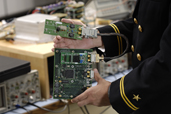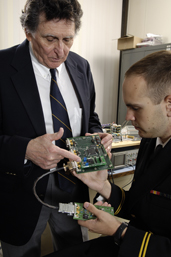Radiation exposure is one of the most serious risks that an astronaut faces in space. If humans are to successfully conduct long-duration exploration missions, devices and procedures must be in place to prevent, protect, manage and treat radiation exposure. Dr. Vincent Pisacane is the principal investigator on a project to develop a prototype real-time microdosimeter-dosimeter instrument (MIDN) – a device designed to determine risks to personnel in radiation fields of unknown intensity and composition. The MIDN, which is based on a design from Pisacane’s previous NSBRI project, will be portable for use on spacesuits, rovers and extravehicular tool boxes. Its real-time measurements of exposure rates will allow astronauts to take action to reduce radiation exposure.
Overview

The microdosimeter instrument consists of small sensors connected to an electronics board, shown here without the casing. Spacesuits integrated with this technology can warn astronauts at the onset of an elevated exposure event, assess risk, and help crews determine safe locations during these periods. Photo by James T. VanRensselaer. Click here for larger image.
Dosimetry: Microdosimeter-Dosimeter Instrument

The electronic output module held by Dr. Vincent L. Pisacane, collects information from sensors housed in various locations within the spacecraft. The microdosimeter will use the measurements to directly estimate radiation risk. Photo by James T. VanRensselaer. Click here for larger image.
Principal Investigator:
James L. Ziegler, Ph.D.
Organization:
United States Naval Academy
Technical Summary
Specific Aims
1) Develop a benchtop system to advance the state-of-the-art of SSDM incorporating proven advancements into the flight engineering model
2) Develop a flight engineering model suitable as a personal SSDM
3) Develop improved SSDM sensors
4) Utilize computer modeling to support instrument development and compare with observations
5) Explore opportunities to transition to a flight program
Key Findings
1) System calibration without Radioactive Materials - A reliable new technology was developed, tested and a NASA Patent was filed for this technology.
2) Space Missions - The MIcro-Dosimeter Nucleon (MIDN – the acronym used in this project for all our micro-dosimeter systems) was launched on the MIDSTAR-I spacecraft in March 2007. It is the only semiconductor micro-dosimeter ever flown in space. Because of observed problems, a second instrument, MIDN-III, is under development based. Improvements to the instrument include: increased use of rad-hard digital electronics in place of analog; power changed to rechargeable dual batteries to reduce noise; increased number of remote commands; and, improved SOI sensors.
3) Radiation Testing of MIDN micro-dosimeters – Extensive testing of new MIDN sensors was carried out with low energy protons, alphas and neutrons, and at NASA Space Radiation Laboratory-Brookhaven National Laboratory (NASA/BNL) facility using MeV/GeV protons and heavy ions. Concurrently, extensive modeling was done with GEANT4. The sensors showed a detection accuracy of better than 20% for most beams, with the GeV heavy-ions showing modest sensor saturation. No measureable degradation of the MIDN sensors.
4) Microdosimetry with Coincident Particle Identification - An experimental system for identifying particle types, energies, and mass-to-charge ratios of beams of energetic particles responsible for events of energy deposition.
5) New Radiation Sensor Designs – Investigation of the response new p-SOI radiation sensors was completed. They had good performance for 2MeV protons and 3MeV alphas. The noise is 4x better than MIDN-II, with noise levels of 0.07 keV/micron (~0.04 keV/micron-tissue). The arrays showed >99% functionality, and absence of cross talk between neighbor SVs qualifying the MIDN-III for higher level production. Other tests used MeV He and C-12 ions. Excellent performance of sensors was demonstrated.
6) Testing Ultra-Small Micro-dosimeters – Evaluation sensors with 1 μm dimensions have been obtained and experiments begun on the critical parameters: dose accuracy, background noise, saturation levels, and system robustness in a radiation environment.
Impacts of Findings
Silicon micro-dosimeters (SMDs) have been shown to have noise levels better than that obtained with TEPCs in space. SMD spectra for space protons will be able to obtain very low-lineal energy detection, a major goal of this research project. Measurements in 2011 of SMD spectra with intense high-energy neutrons (~14 MeV) show that SMD can operate in high-dose radiation fields for long time periods without failures. This establishes the radiation resistance of our SDMs, a major goal. Measurements in 2011 with SDM systems at the NSRL facility at BNL established the practicality of using our new capability of identifying particle species: i.e., energy and charge-to-mass ratio responsible for specific individual events. Such measurements provide more stringent data for establishing quality factors and the accuracy of the transport codes, a major aim.
Recent measurements with SMD in a plastic phantom on a HIMAC beamline (in Japan) demonstrated the success of MIDN-III sensors for deep space missions by showing equivalent performance to TEPC instruments. Development of an end-to-end system test and calibration of an astronaut's personal SMD without the need for an ionizing radiation source is an important achievement. The final testing of MIDN-II sensors, and the design and highly-successful early testing of the MIDN-III sensors (probably final flight qualifiable personal SMDs) are important accomplishments.
Research Plan for 2012
1) Obtain MIDN-III microdosimeter sensors. Obtain commercial 1um SOI detectors.
2) Design and build evaluation/test electronic sensor analysis systems.
3) Complete electronic testing on all 9 MIDN sensor technologies, and five commercial sensors. Evaluate and select the top two models for inclusion in the final prototype system.
4) Test final SMD selections for accuracy with particle beams: protons, alphas and neutrons. Compare with computer modeling to determine sensor accuracy. Determine any sensor non-linearity or signal saturation. Determine sensor reliability under extended radiation.
5) From radiation testing, search for sensor blooming (a single particle causing events in several sensors),signal saturation, and non-linear effects.
6) Establish final space-suitable dosimetry system goals and required displays.
7) Establish communication links between astronaut suit system and base-station monitor.
8) Build two complete flight engineering prototypes: An astronaut suit system with helmet warning and a Station monitoring system.
9) Test systems for sensitivity to external vibration, mechanical ruggedness and sensitivity to external RF radiation.
10) Run ground tests for power consumption and establish suitable power packs.
11) Test prototypes with MeV ions.
12) Delivery of final flight engineering model with calibration spectra and microdosimetric spectra to NASA/NSBRI.
13) Flight Opportunity – Continue to work with the DoD Space Test Program Office to obtain a future flight opportunity.
Earth Applications
With sufficient investment in VLSI technology the solid-state microdosimeter can be integrated into a cell-phone sized instrument. Since microdosimetry provides the regulatory risks from radiation exposure in real time, it can be beneficially used by first responders in emergency situations when there is uncertainty in the radiation risk. The microdosimeter can be used in nuclear power plants and other facilities with radioactive materials to provide risk due to exposure. It can also be used to detected contraband radioactive material; because of its compact size and potentially relatively low cost, it can be used in situations where large numbers of sensitive detectors are needed.
Development of SOI microdosimeters has a potentially significant impact on applications to monitor the dose equivalent during proton therapy to reduce the possibility of secondary cancers generated in normal tissue by the radiation.
Development of our calibration technique that does not use an ionizing radiation source will reduce the exposure of handlers of the microdosimeter. It will also eliminate the cost of satisfying the regulations on certification of users and on the handling, shipping, and facilities.





